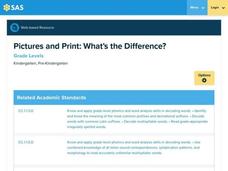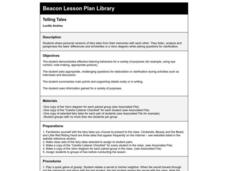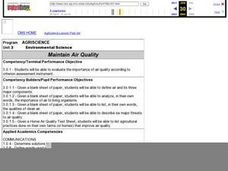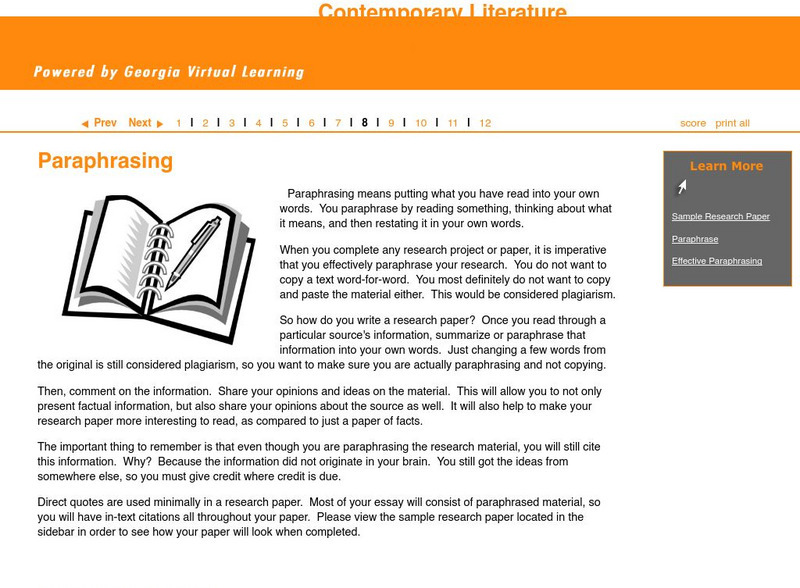Curated OER
Dragonwings
Students engage in a activity that is concerned with the literature study of Dragonwings. They write about the story from the perspective of a reader that is well informed towards the last chapters. Students also find target vocabulary...
Curated OER
Stanley's Story
Students create a newspaper story based on the events that occur in the novel Holes. They recall the basic facts of Stanley's story using the 5 W's plus H. Students write a fact based news story based on the information presented in...
Curated OER
The Cycle of Life
Eighth graders search for rites of passage in their own lives and study rites of other cultural groups in Louisiana and around the world. They assess how to recognize moments of importance in people's lives and find meaning in the stages...
Curated OER
The Work of our (Divine) Hands
Young scholars explore ethical "mitzvots." In this philanthropy lesson, students consider how to lead their lives ethically according to the dogma of mitzvot. Young scholars discuss the consequences of their actions.
Curated OER
You and Me and God Make Three!
Middle schoolers examine the concept of Divine origin as it relates to tolerance. In this tolerance instructional activity, students learn to explain the creation of humanity in the Divine image. They discuss how to live with the tenet...
Curated OER
Can You Find a Solution?
Students explore the topic of public conservation. In this Florida panthers lesson, students read a scenario about the endangered panther and collaborate to plan a way to protect the panther population. Students also participate in a...
Curated OER
The Wyandotte Constitutional Convention: The Issue of Suffrage
Seventh graders discover details about the Wyandotte Constitutional Convention. In this Kansas history lesson, 7th graders tackle civil rights concerns as they draft persuasive speeches to secure the rights of young voters in the state.
Curated OER
Apply Post-Reading Skills and Discuss Persuasive Text
Students put their reading comprehension skills to practice. In this interpreting text instructional activity, students read "Chief Red Jacket's Reply," and then respond to questions that require them to reason, infer, and analyze the...
Curated OER
Tooling Around Arizona: Reading Arizona Maps
Students research Arizona maps. In this map lesson, students discuss map titles, scales, directions, elevation, and symbols. The class will examine topography, landforms, and rivers found on an Arizona map.
Pennsylvania Department of Education
Pictures and Print: What's the Difference?
Learners watch a PowerPoint presentation. In this early literacy lesson, students watch a PowerPoint presentation describing print from pictures and the difference between the two.
Curated OER
Telling Tales
Students verbally tell partners a personal version of a fairy tale to each other. They listen, analyze, and describe the tales' differences and similarities in a Venn diagram.
Curated OER
From Home to Nome
Third graders develop and create an electronic portfolio on their hometown, school, and themselves to send to a school on the Iditarod Trail. They gather information from the Internet, printed materials, and a digital camera.
Curated OER
Author, Author!
Third graders, in groups, select and research a favorite studenT author or illustrator. They answer questions about the author, conduct research and prepare a PowerPoint presentation with their findings.
Curated OER
Promoting the South Carolina Junior Book Award Nominees
Sixth graders recongize and analyze different components of a piece of literature. They must also practice their oral communcation skills by reading a book to an audience.
Curated OER
Maintain Air Quality
Students are engaged in discussing air quality through hands-on demonstrations using balloons, sealed jars, and toy cars. Students conduct a home radon test to measure their air quality.
Curated OER
Slavery
Students use primary and secondary source documents to look into the story of slavery told about "Pink". The original documents like a bill of sale for the slave is used for example. The students write notes about the research and think...
Curated OER
Short Story 2
Seventh graders review previous reading of Rikki Tikki Tavi. They discuss prior knowledge of simile, metaphor, idiom, and hyperbole. Students practice using vocabulary words from the story by listing synonyms for them. Students read from...
Curated OER
A Journey To Africa: Art And Artifacts
Students create a multimedia presentation based on a piece of African Art. They use the art piece to demonstrate the culture and ceremonies of the area in which it was produced. They research facts for a Power Point, write a poem...
Online Writing Lab at Purdue University
Purdue University Owl: Quoting, Paraphrasing, and Summarizing
Provides guidance on the ways to quote, paraphrase, and summarize information. Gives various reasons for paraphrasing, summarizing, and quoting various sources.
Georgia Department of Education
Ga Virtual Learning: Technology and the World Around Us: Paraphrasing
This lesson focuses on the importance of paraphasing and how to paraphrase to avoid plagiarism. It provides links to an example of an MLA research paper, an article of effective paraphrasing, and a "Purdue Owl: Paraphrase" entry showing...
Texas Education Agency
Texas Gateway: Summarizing, Paraphrasing, and Quoting Source Material Accurately
You will learn how to summarize, paraphrase, and quote material from your sources.
Sophia Learning
Sophia: Summary and Paraphrase: Tutorial
In this slideshow tutorial, students are provided with notes that distinguish "summarizing" from "paraphrasing" content. Examples of effective summaries and paraphrases of text are provided. Then students have the opportunity to engage...
Lumen Learning
Lumen: Using Sources: Paraphrase and Summary
This lesson focuses on how to integrate source material using paraphrase and summary and the differences between the two. It also provides a practice exercise.
Lumen Learning
Lumen: Using Sources: Applying Paraphrase, Summary, and Quotation
This instructional activity focuses on when to use paraphrase, summary, and quotation to integrate source material into your paper.

























